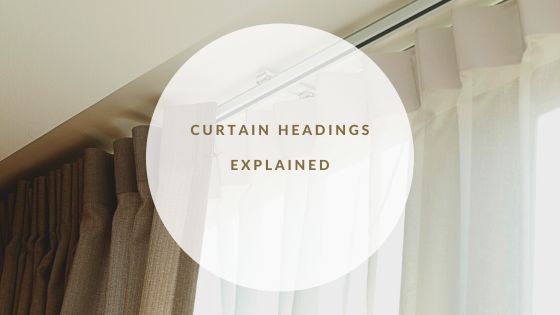Please wait...
Curtain Headings Explained
This entry was posted 02/05/2023

Window treatments are an important aspect of any room. It can set the tone for the design while also providing privacy and blocking out light. One important element of window treatments is the curtain heading. Understanding the different types of curtain headings and how to choose the right one can make a big difference in the overall look and feel of the room. In this article, we will be discussing everything you need to know about curtain headings.
Importance of Choosing the Right Curtain Heading
The curtain heading is the top part of the curtain that attaches to the rod, pole or track. It's an important aspect of the curtain because it determines how the curtain will hang and how it will look when it's open or closed. Choosing the right curtain heading can make a big difference in the overall look and feel of the room.
If you choose the wrong type of curtain heading, it can make the curtains look cheap or unprofessional. For example, if you choose a heading that's too small for your curtains, they may not hang properly and will look awkward. On the other hand, if you choose a heading that's too large, it can make the curtains look heavy and overwhelming.
Different Types of Curtain Headings
There are several different types of curtain headings, each with its own unique style and function. Here are some of the most popular types of curtain headings:
Wave Curtain Headings
Wave headings are a modern and sleek option that creates a uniform wave effect across the top of the curtains. This type of heading is often used with lightweight and sheer fabrics to create a soft and elegant look.
One of the benefits of wave headings is that they are easy to install and operate. The curtains glide smoothly along the track, making them a great choice for large windows or sliding doors.
Tab Top Curtain Headings
Tab top headings are a more casual option that's often used in bedrooms, kitchens, and bathrooms. This type of heading features fabric loops that are sewn onto the top of the curtain, which are then looped over the rod.
Tab top curtains are easy to install and can be easily removed for washing. They're also a great option if you want to add a pop of color or pattern to your room.
Eyelet Curtain Headings
Eyelet headings are a popular option for modern and contemporary interiors. This type of heading features metal rings that are sewn onto the top of the curtain, which then slide onto the rod.
One of the benefits of eyelet headings is that they create a clean and streamlined look. They're also a great option if you want to use a bold pattern or color for your curtains.
Pinch Pleat Curtain Headings
Pinch pleat headings are a traditional and elegant option that's often used in formal living rooms and dining rooms. This type of heading features small pleats that are sewn into the fabric, which create a tailored and sophisticated look.
One of the benefits of pinch pleat headings is that they can make the curtains look more full and luxurious. They're also a great option if you want to use a heavy or thick fabric for your curtains.
Goblet Pleat Curtain Headings
Goblet pleat headings are a dramatic and ornate option that's often used in grand and formal spaces. This type of heading features a large pleat that's shaped like a goblet, which creates a dramatic and luxurious look.
One of the benefits of goblet pleat headings is that they add a touch of elegance and sophistication to any room. They're also a great option if you want to use a heavy or thick fabric for your curtains.
Rod Pocket Curtain Headings
Rod pocket headings are a simple and classic option that's often used in casual spaces. This type of heading features a pocket that's sewn into the top of the curtain, which the rod is threaded through.
One of the benefits of rod pocket headings is that they're easy to install and can be easily removed for washing. They're also a great option if you want to use a lightweight or sheer fabric for your curtains.
Choosing the Right Curtain Heading Style for Your Room
When choosing a curtain heading style for your room, there are several factors to consider. Here are some things to keep in mind:
Style of the Room
The style of the room should be the first factor to consider when choosing a curtain heading style. For example, if you have a modern and minimalist room, a wave heading may be the best choice. On the other hand, if you have a formal and traditional room, a pinch pleat heading may be more appropriate.
Type of Fabric
The type of fabric you choose for your curtains will also influence the type of curtain heading you should choose. For example, if you have a heavy and thick fabric, a pinch pleat or goblet pleat heading may be the best choice. On the other hand, if you have a lightweight and sheer fabric, a wave heading may be more appropriate.
Size of the Window
The size of the window should also be considered when choosing a curtain heading style. For example, if you have a large window or sliding door, a wave heading may be the best choice. On the other hand, if you have a small window, a tab top or rod pocket heading may be more appropriate.
How to Hang Curtains with Different Types of Curtain Headings
Once you've chosen the right curtain heading style for your room, it's important to know how to hang them properly. Here are some tips for hanging curtains with different types of curtain headings:
Wave Curtain Headings
To hang wave curtains, you'll need a track that's specifically designed for this type of heading. The track should be installed above the window, and the curtains should be attached to the track using special gliders.
Tab Top Curtain Headings
To hang tab top curtains, you'll need a rod that's the appropriate size for the fabric loops. The rod should be installed above the window, and the loops should be looped over the rod.
Eyelet Curtain Headings
To hang eyelet curtains, you'll need a rod that's the appropriate size for the metal rings. The rod should be installed above the window, and the rings should be slid onto the rod.
Pinch Pleat Curtain Headings
To hang pinch pleat curtains, you'll need hooks that are specifically designed for this type of heading. The hooks should be inserted into the small pleats, and then the hooks should be attached to the rod.
Goblet Pleat Curtain Headings
To hang goblet pleat curtains, you'll need hooks that are specifically designed for this type of heading. The hooks should be inserted into the large pleat, and then the hooks should be attached to the rod.
Rod Pocket Curtain Headings
To hang rod pocket curtains, you'll need a rod that's the appropriate size for the pocket. The rod should be installed above the window, and the pocket should be threaded onto the rod.
Conclusion
In conclusion, choosing the right curtain heading is an important aspect of any window treatment. There are several different types of curtain headings to choose from, each with its own unique style and function. When choosing a curtain heading style for your room, it's important to consider the style of the room, the type of fabric, and the size of the window. By following these tips and techniques, you can create a beautiful and functional window treatment that complements your room perfectly.
This entry was posted in Hints and Tips on 02/05/2023

